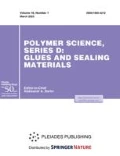Abstract
Using the example of engineering products, a model is proposed for visualizing their quality indicators at various stages of the life cycle: during production, repair, and operation. The Liebig barrel was adopted as a model, which made it possible to use the principle of cybernetics, according to which the product at each stage of its life cycle is represented as a set of separate elements connected to each other in a single information network.



Similar content being viewed by others
REFERENCES
Technological Support and Improving the Operational Properties of Parts and Joints, Ed. by A. G. Suslov (Mashinostroenie, Moscow, 2006) [in Russian].
A. S. Vasil’ev, “Technological heredity in mechanical engineering,” Vestn. Rybinsk. Gos. Aviats. Tekhnol. Akad. im. P. A. Solov’eva, No. 1, 198–202 (2017).
G. A. Rastorguev, “The manifestation of technological heredity in the operation of machines and mechanisms,” Remont Vosstanov. Modernizatsiya, No. 12, 32–40 (2013).
S. L. Bazhenov, A. A. Berlin, A. A. Kul’kov, and V. G. Oshmyan, Polymer Composite Materials (Izd. Dom Intellekt, Dolgoprudny, 2010) [in Russian].
G. V. Malysheva, E. S. Akhmetova, and Y. Y. Shimina, “Determination of phase transition temperatures of polymer binding agents by differential scanning calorimetry,” Polym. Sci., Ser. D 8 (1), 17–21 (2015).
V. Nelyub and G. Malysheva, “Modern treatment technologies of carbon fibre for ensuring the high strength carbon fibre reinforced plastic,” MATEC Web Conf. 129 (2017).
N. I. Baurova, “Durability models of adhesive materials using catastrophe theory,” Polym. Sci., Ser. D 2 (2), 130–132 (2009).
N. I. Baurova, V. A. Zorin, and V. M. Prikhodko, “Description of scenarios of transition of material from an operable to inoperable state using an equation of fold catastrophe theory,” Polym. Sci., Ser. D 8 (1), 1–5 (2015).
N. I. Baurova, V. A. Zorin, and V. M. Prikhodko, “Taking into account the factors of technological heredity by technological mechanics,” Polym. Sci., Ser. D 9 (4), 402–406 (2016).
V. I. Arnold, Catastrophe Theory, 3rd ed. (Springer-Verlag, Berlin, 1992; URSS, Moscow, 1997).
V. A. Ostreikovskii, Analysis of the Stability and Controllability of Dynamic Systems by Methods of Catastrophe Theory: Textbook (Vyssh. Shk., Moscow, 2005) [in Russian].
I. Prigogine, From Being to Becoming: Time and Complexity in the Physical Sciences (W. H. Freeman, San Francisco, 1980; Mir, Moscow, 1985).
Author information
Authors and Affiliations
Corresponding author
Ethics declarations
The authors declare that they have no conflicts of interest.
Additional information
Translated by M. Aladina
Rights and permissions
About this article
Cite this article
Baurova, N.I., Konoplin, A.Y. Visualization of the Dynamics of Measuring Processes of the Quality Indicators of Engineering Products during Production, Repair, and Operation. Polym. Sci. Ser. D 13, 193–196 (2020). https://doi.org/10.1134/S1995421220020045
Received:
Revised:
Accepted:
Published:
Issue Date:
DOI: https://doi.org/10.1134/S1995421220020045




